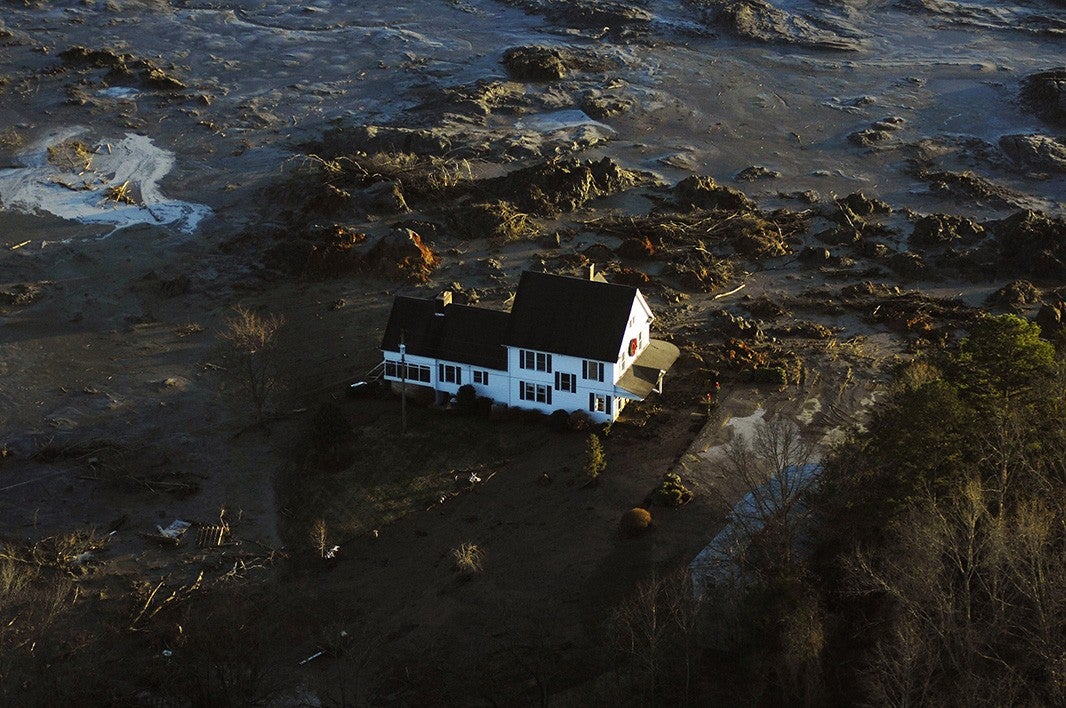More Coal Ash Disasters in Waiting
EPA finds eight more dangerous coal ash ponds in poor condition

This page was published 11 years ago. Find the latest on Earthjustice’s work.
Late last month, the U.S. Environmental Protection Agency quietly released inspection reports of coal ash ponds at 26 plants in 11 states. At eight plants, the agency found toxic lagoons in poor condition, encompassing almost a third of all the sites. These coal ash ponds lacked proper maintenance and/or routine safety analyses to ensure prevention of another disaster like the massive spills at the TVA Kingston plant in 2008 and Duke Energy’s Dan River Plant last February.
These latest inspections are the EPA’s 12th round of published reports. After the largest toxic waste spill in U.S. history in Tennessee in 2008, the EPA initiated dam inspections to assess the condition of the nation’s 1,070 coal ash ponds. To date, the EPA has conducted more than 550 inspections. This latest round confirms the alarming conclusions of hundreds of prior inspections—approximately 25 percent of the nation’s largest toxic lagoons are in “poor” condition. The EPA found less than half of these coal ash impoundments in “satisfactory” condition.
Yet this deeply disturbing news has triggered no alarms and even less action.
The EPA continues to identify significant problems at coal ash dams nationwide, but no federal rule requires that the problems be fixed. All fixes are voluntary, and to make matters worse, the EPA conducts no follow-up on its inspections. When and how the problems are fixed is totally up to each utility. Without oversight, communities near potentially deadly toxic lagoons are in grave danger.
Who should be concerned? From 2009–2014, the EPA identified 152 coal ash ponds in poor condition. Below are the eight plants with newly identified poor-rated ponds:
- Columbia Municipal Power Plant, Columbia, MO: High hazard pond rated poor.
- Gulf Power Plant Scholz, Sneads, FL: Significant hazard pond rated poor.
- City of Ames Power Plant, Ames, IA: Significant hazard pond rated poor.
- J.B. Sims Power Plant, Grand Haven Michigan: Two significant hazard ponds rated poor.
- NRG Power Midwest Elrama Power Station, Elrama, PA: Significant hazard pond rated poor.
- Gainesville Regional Utility Deerhaven Plant, Gainesville, FL: Low hazard pond rated poor.
- Plant Crisp, Warwick, GA: Low hazard coal ash pond rated poor.
Let’s examine one site in more detail: The conditions at the Columbia Municipal Power Plant in Missouri are especially alarming. The EPA found that Columbia’s high-hazard coal ash pond may not be able to survive a significant rain event without overtopping or spilling. For over six decades, Columbia has dumped toxic coal ash sludge in an unlined lagoon originally built as a recreational lake in the 1800s. In 1980, the U.S. Army Corp of Engineers determined that the impoundment could only pass 50 percent of a Probable Maximum Precipitation (PMP) event without overtopping. (A PMP event is defined as the flood discharge that may be expected from the most severe combination of critical meteorological and hydrologic conditions that are reasonably possible in the region.) Currently, the Missouri Department of Natural Resources requires that impoundments pass 75 percent of a PMP event. The EPA’s report concludes that dam performance is vulnerable to potential problems during a variety of conditions beyond a 50 percent PMP (heavy rain). According to the EPA, in the event of a dam break, loss of human life would be expected as well as high economic damages, and the impact would extend up to two miles from the plant.
Yet apparently, the EPA is in no hurry. Although the agency only recently released these reports, they are not new. The dam inspections were conducted more than two years ago—which raises the question of why these deadly toxic lagoons are not made safe immediately after problems are uncovered. The fact that two-year-old inspections are just coming to light reveals the incomprehensible lack of urgency by the EPA for protecting public safety and the environment.
This situation may change on December 19, when the EPA finalizes the first federal coal ash rule. If it doesn’t, or if the rule fails to require closure of dangerous toxic lagoons, more collapses are sure to come.
Established in 2008, Earthjustice’s Northeast Office, located in New York City, is at the forefront of issues at the intersection of energy, environmental health, and social justice.